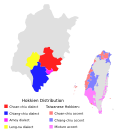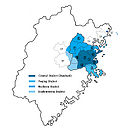Differing literary and colloquial readings for certain Chinese characters are a common feature of many Chinese varieties, and the reading distinctions...
32 KB (2,583 words) - 08:39, 3 August 2024
communication; literary readings are close to modern Mandarin, normally appearing in written language. The literary and colloquial readings have been developing...
16 KB (1,366 words) - 00:49, 2 June 2024
Sichuanese dialects (category Pages with non-English text lacking appropriate markup and no ISO hint)
Mandarin, while literary readings tend to resemble modern standard Mandarin. For example, in the Yaoling dialect (摇铃话), the colloquial reading of "物" (means...
32 KB (2,556 words) - 14:47, 1 November 2024
Amoy dialect (category City colloquials)
complex rules for literary and colloquial readings of Chinese characters. For example, the character for big/great, 大, has a vernacular reading of tōa ([tua˧])...
28 KB (2,630 words) - 07:36, 18 June 2024
Hokkien (section Literary and colloquial readings)
both literary and colloquial readings: This feature extends to Hokkien numerals, which have both literary and colloquial readings. Literary readings are...
117 KB (10,356 words) - 08:47, 23 November 2024
Fuzhou dialect (redirect from Foochow colloquial)
as follows: The literary and colloquial readings is a feature commonly found in all Chinese dialects throughout China. Literary readings are mainly used...
64 KB (5,133 words) - 13:53, 22 November 2024
in initial, rime and tone: 網 ([mœŋ˦˨] / [uoŋ˧˨]) When there is a difference between literary and colloquial readings, the colloquial one is used in vernacular...
45 KB (4,094 words) - 09:15, 9 November 2024
On'yomi (redirect from On reading)
"dō" and 泉 "sen". In Chinese, most characters are associated with a single Chinese sound, though there are distinct literary and colloquial readings. However...
9 KB (861 words) - 13:44, 6 November 2024
[y] and [u] in Mandarin, along with eastern Shanxi and some Southwestern Mandarin dialects. The existence of literary and colloquial readings is a notable...
29 KB (3,610 words) - 17:33, 31 October 2024
words, they usually only have native kun readings. However, they occasionally also have a Chinese on reading derived from a related kanji, such as 働 (dō...
10 KB (1,113 words) - 18:06, 20 November 2024
set of traditional characters is regulated by the Ministry of Education and standardized in the Standard Form of National Characters. These forms were...
25 KB (2,332 words) - 16:05, 22 November 2024
/ˈrɛdɪŋ/) may also refer to: Literary and colloquial readings of Chinese characters Readings of kanji in Japanese Reading (computer), an action performed...
4 KB (497 words) - 02:17, 4 September 2024
previous jōyō kanji list. Twenty-eight kanji gained new readings, three kanji lost obscure readings and the kun'yomi of 側 was changed from kawa (かわ) to gawa...
13 KB (1,004 words) - 13:49, 18 November 2024
characters (see Literary and colloquial readings of Chinese characters). The following examples in Pe̍h-oē-jī show differences in readings in Taiwanese Hokkien:...
22 KB (2,593 words) - 07:28, 24 November 2024
Chữ Nôm (redirect from Nôm reading)
hiragana and katakana. When a character would have two readings, a diacritic may be added to the character to indicate the "indigenous" reading. The two...
67 KB (7,208 words) - 05:13, 2 November 2024
Suzhou dialect (category City colloquials)
fully merged with 阳去 tone. Therefore, 买 and 卖 has the exact same pronunciation in literary and colloquial readings. The tone sandhi present in Suzhou dialect...
20 KB (1,638 words) - 08:18, 16 November 2024
Homograph (redirect from Heterography and homography)
Chinese often come into existence due to differences between literary and colloquial readings of Chinese characters. Other homographs may have been created...
9 KB (693 words) - 09:42, 23 October 2024
Wu Chinese (category Harv and Sfn no-target errors)
Shanghainese. Wu, like other Chinese languages, have literary and colloquial readings of many characters. The literary layer was brought to the region during the...
110 KB (11,793 words) - 13:14, 21 November 2024
among non-Mandarin regional languages in having a written colloquial standard, used in Hong Kong and overseas, with a large number of unofficial characters...
39 KB (4,712 words) - 12:22, 31 July 2024
Classical Chinese (redirect from Literary Chinese)
additionally developed systems of readings and annotations that enabled non-Chinese speakers to interpret Literary Chinese texts in terms of the local...
28 KB (3,060 words) - 08:10, 23 November 2024
and was adopted as the formal script across all of China during the Qin dynasty (221–206 BC). It was still widely used for decorative engraving and seals...
8 KB (866 words) - 16:25, 24 November 2024
developed within the state of Qin during the Eastern Zhou dynasty (771–256 BC), and was then promulgated across China in order to replace script varieties used...
4 KB (435 words) - 22:58, 13 October 2024
Kanji (redirect from Onyomi and kunyomi)
literary and colloquial readings of Chinese characters—borrowed readings and native readings. In Chinese these borrowed readings and native readings are...
94 KB (9,725 words) - 14:09, 28 October 2024
Doublet (linguistics) (category Lang and lang-xx template errors)
Differing literary and colloquial readings of certain Chinese characters are common doublets in many Chinese varieties, and the reading distinctions...
31 KB (3,188 words) - 11:44, 21 October 2024
Chinese characters (category Articles containing Literary Chinese-language text)
local spoken vernaculars, texts were read aloud using literary and colloquial readings that varied by region. Over time, sound mergers created ambiguities...
121 KB (14,122 words) - 07:34, 23 November 2024
Mandarin Chinese (section Further reading)
China and Taiwan, with minor vocabulary differences. It is the Mandarin variant used in education, media, and official settings. Meanwhile, a colloquial form...
85 KB (8,801 words) - 08:53, 22 November 2024
Chinese bronze inscriptions (section Spring and Autumn)
dynasty (c. 1250 – c. 1046 BC) and Western Zhou dynasty (c. 1046 – 771 BC). Types of bronzes include zhong bells and ding tripodal cauldrons. Early inscriptions...
25 KB (3,077 words) - 03:59, 25 September 2024
teachers when reading aloud HKWC texts in the colloquial pronunciation. Some regular differences between colloquial and literary readings in Cantonese...
15 KB (1,447 words) - 18:32, 23 November 2024
Standard Chinese (section Guoyu and Putonghua)
cinema' (国语电影; Guóyǔ diànyǐng). In Taiwan, Guoyu is the colloquial term for Standard Chinese. In 2017 and 2018, the Taiwanese government introduced two laws...
82 KB (8,055 words) - 23:40, 9 November 2024
strokes to different keys and adopted a new way of categorizing Chinese characters. But the typewriter was not produced commercially and Lin soon found himself...
14 KB (1,512 words) - 15:38, 8 June 2024

















